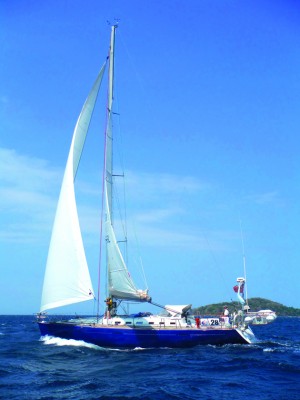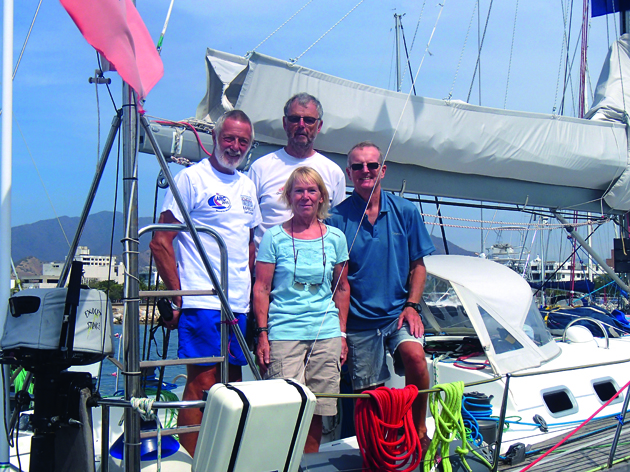4. DIY on a budget
Oyster 41, Pentagram
Andy Middleton and Emma White are proof that you don’t need to be wealthy or retired to set off for the big blue. They sold their homes, including a narrowboat that Emma had lived on for 21 years, a car and motorbike to fund their dream to sail round the world. “It’s about making that decision,” says White, “getting out of the security.”
They bought Pentagram, a 1983 Oyster 41, five years ago. They had no choice but to do most of the work themselves to keep the cost down. They plan to stop halfway round the world to do some work to fund further travels.
Andy Middleton completely renovated Pentagram. His substantial job list included checking the keel bolts, renewing the wiring, fitting a new engine, gearbox and prop, replacing standing rigging, checking the bearings and water seals, stripping and repainting the deck and replacing the stanchions. He also fitted new gas pipes and a new gas locker to accommodate larger propane bottles that they could replace worldwide.
As well as a lifetime of sailing and racing, Middleton is a steel fabricator by trade, which meant he could tackle these tasks. To keep a lid on costs, most of the work was done while the boat was afloat in Dartmouth, including hoisting the old engine out using the boom and lowering it into their small inflatable tender.
Andy Middleton also changed all the lighting to LED, fitted a compressor fridge and doubled the battery bank to 440ah.
He installed a wind generator and two solar panels – “so 90 per cent of the time we’ve got all the power we need,” says Middleton. “We spent two and a half weeks at anchor in Barbados with no engine needed.”
He says the biggest consumer of power, he’s found, is the autopilot, which they chose to upgrade to Raymarine’s latest Evolution 200 model; it has proved “absolutely fantastic”.
Pentagram has only a 60lt diesel tank, so numerous fuel and water containers are carried on deck. Emma White singled out the Instant Trust Marine water in-line filter they fitted, an ingenious device developed with Philips to kill off viruses and bacteria in water using UV radiation.
“There are so many things that could have stopped us from going,” reflects Middleton. “We wanted a watermaker, for example, but you get to a stage where you’ve only got so much money and you need to just go. You’ve got to be reasonably happy with what you’ve got – and then go for it.
“We don’t want to be looking back when we’re older and saying ‘what if’. . .”
5. Second-hand resourcefulness
Beneteau First 47.7, Exocet Strike
On the face of it Exocet Strike looks just like many of the stalwarts of the race charter fleet. But I was taken with how well the owners of this 2002-built First 47.7 had equipped her for long-term passagemaking. John and Stella Dyer point out how many of the parts and spares needed to ready a yacht are available for a keen price on the second-hand market.
The result of their careful shopping is that the Dyers now have a very well-equipped yacht with a vast spares inventory. This includes “virtually a spare autopilot, including a pump and ram – all eBay specials,” declares John Dyer.
Dyer did a lot of the installation work himself, replacing every through-hull fitting and seacock with bronze ones over the last two years before they set off. “If I fit it myself and it goes wrong, I have a better idea of how to fix it,” he reasons.
Dyer had been running Exocet Strike as a skippered charter boat out of Plymouth and had been planning this voyage since 2005. But they had to wait until Stella could retire from her demanding role as a managing partner for a firm of solicitors in Plymouth before they could set sail.
“We have probably spent around £50,000 on preparing the boat – but that’s because we chose to upgrade the sails and rigging,” explains Dyer. “We did have a budget with ‘must haves’ and ‘would likes’.”
“But every time we bought something the budget just kept going up!” puts in Stella.
A new suit of sails was the Dyers’ biggest outlay. “We set up the boat to make it easier to sail, including a No 3 genoa and a fully battened main with stackpack,” Dyer explains. They chose single, high-spec, UV-proof Dacron sails from Sanders so they could be repaired worldwide. A DuoGen, an SSB radio, satphone, davits and a dinghy have all been bought second-hand or on eBay. A Kevlar Code 0 on a Karver furler was a luxury for offwind Pacific sailing.
All the halogen bulbs were replaced with LEDs, including navigation lights, which reduced power consumption on board from 20amps down to under 2amps. And to provide self-sustainability the Dyers also installed a generator and a watermaker.
The watermaker involved copious research, as Dyer had read a lot about the potential electronics problems of automatic types. In the end he fitted an Aquamax with a manual control panel under the saloon berth.
“I’ve tried to go for the simplest things so I can resolve any problems,” explains Dyer.
6. Last-minute decision to go
Lagoon 620, Makena
The owners of the largest boat in this year’s World ARC fleet had the least time to prepare. Luc and Sarah Barthelet bought Makena new in June last year and only entered the World ARC two weeks before the start in December.
“In September 2013 a friend of mine posted a picture of himself in Bora Bora,” explains Luc Barthelet. “This made me question what we were doing.” At the time the couple were living in San Francisco working for large computer software companies, but in that moment they decided to quit their jobs, sell the house and sail round the world. Two months later Barthelet was on a factory visit and sail trial in France, and they took possession of Makena – and baby Kai – the following summer.
Why such a big cat? The Barthelets have a large family, including parents and children in France and Ireland. They wanted to be able to spend quality time with them and include them in their adventure. They decided on a ‘quick world tour’ then a slower circumnavigation. “Racing sailors call these big catamarans condominiums, but that’s what we were looking for,” says Barthelet.
For the voyage, all they added to the Lagoon tickbox of options was an SSB radio and a cot for their baby boy. In the first three months they took on board 60 people, each staying for up to two weeks. “We realised we were not well enough prepared to do a world tour ourselves,” admits Barthelet after crossing the Atlantic with ARC+ in November. He has sailed since he was five and is the son of a sailing teacher in Normandy, but it was the logistical structure they were missing.
Signing up to the World ARC provided that structure. “Plus we’re visiting places we never would have stopped at on our own.”
“We had already extracted ourselves from daily life, so it was easy to join (in two weeks),” puts in Sarah, “which we did.”
Also relevant to a longer cruise is our feature on 30 tips for crossing the Atlantic
This is an extract from a feature in Yachting World May 2015










